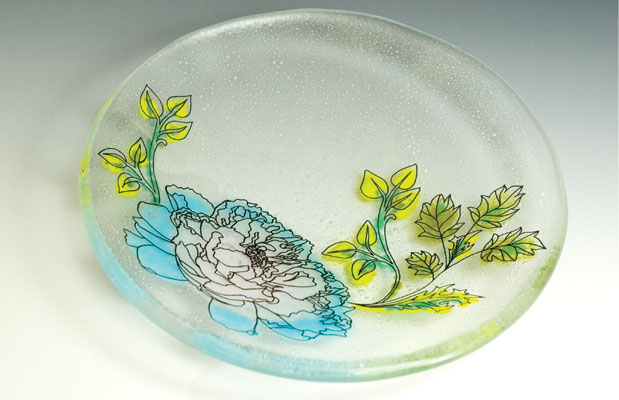Storage Instructions:
When storing your decals before use, keep them upright and in a cool, dry place.
Application Instructions:
- Make sure to thoroughly clean the surface of the glass where you will be placing your decal.
- Discard the protective top layer of wax paper from the decal surface. It should be a loose layer that comes off easily. It is just there to keep the decal from sticking to the packaging.
- If you are using a larger pattern, cut the decal to your desired shape using an exacto knife or scissors.
- Decals go on your finished, fire polished piece. Decal firing is the last step to finishing your glass artwork. Because our decals are made from fine glass powder, you are welcome to experiment with capping, however, as the glass layers fuse together, they will spread somewhat and pull on the decal design, diffusing or breaking apart the finer lines. While this might be used for interesting effects, it is not recommended if you want the decals to have a perfect finish.
- Soak the decal in a shallow dish of warm water until it easily slides off the paper. It is a lot easier to apply the decal straight from the paper to the glass piece, so try to pick up the decal while it’s still on the paper and gently slide the decal onto your glass from there. Leaving a decal in the water too long will result in it floating off the base paper, which can make it more difficult to apply. Change your water frequently to reduce impurities in the water and water-soluble gum that builds up from soaking the decals.
- Gently blot any excess water and smooth out any wrinkles or air bubbles using a paper towel. For larger decals, using a damp lint-free cloth or paper towel to pat down the decal from the middle toward the outer edges until all the excess water has been removed and air bubbles have been smoothed out.
- Very important: If any air bubbles remain at all, they will form tiny holes that will pop through the decal when fired, damaging the design.
- Decals and glass must be completely dry before firing! Overnight drying is highly recommended to help ensure perfect results.
Firing Instructions for Glass Fusing Decals:
Slow preheating is quite important when firing glass decals, as the base medium of the decal must be burned off gently. Good ventilation will allow for a nice clean finish, so it is recommended that you leave your kiln lid open 1-2 inches, plus any peepholes. Heat your kiln slowly to 1000ºF degrees to prevent pinholes or blisters and then proceed with normal ramping.
Soak the decals at 1100ºF for approximately 5-8 minutes. Start with a shorter amount of time and check your results. If you can still see the outline of the transfer medium on the decal, you did not fire hot or long enough. If you are checking your glass every few minutes at 1100ºF, you’ll be able to find the right amount of time that works in your unique kiln setup.
Once your glass has annealed, if you still see the outlines of the base material from the decals, that’s okay! You can always re-fire the piece a little hotter and a little longer with no harm.
When starting out with something new, it’s better to under-fire than to over-fire your work. It’s always good to get to know how your kiln works and to take notes so that you can modify your firing schedule accordingly. Every studio and kiln is unique, so these guidelines should help you establish a firing schedule that is perfect for your kiln setup.
You are always welcome to email Michelle for help and with any other questions you may have! info@glassfusingdecals.com
Firing Schedule: (Note: These are merely guidelines, so be sure to get to know your kiln and make adjustments as needed)
This is for Low-Fire decals made for low-fire temperatures, which go up to around 1120ºF. This is useful because the temperature is low enough to prevent work from slumping as the decal matures.
250 DPH to 350oF, HOLD for 20 minutes
500 DPH to 1000oF HOLD for 10 minutes
AFAP to 1100-1120oF HOLD for 5-8 minutes
Drop to 1000oF, and follow your regular annealing/cooling schedule
High-fire decals should follow a similar schedule, but should be fired up to a maximum temperature of 1400-1420oF, as higher temperatures will burn the decals right off the glass.
